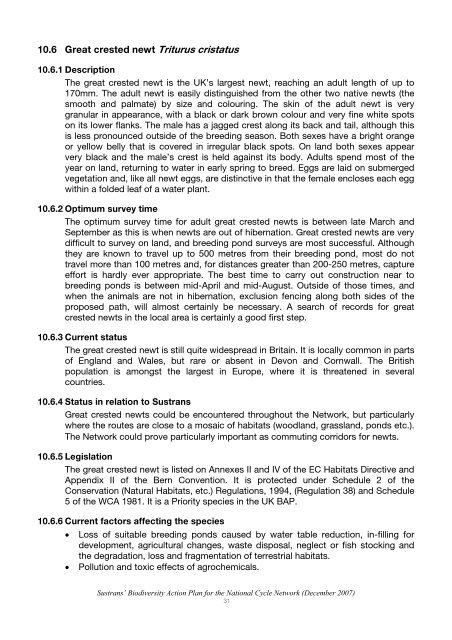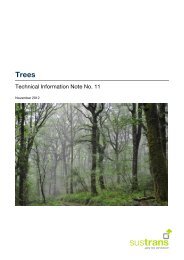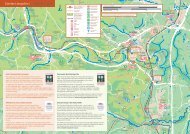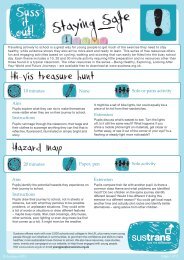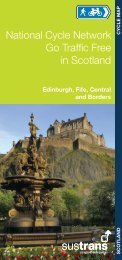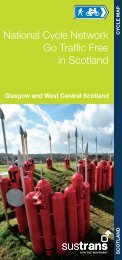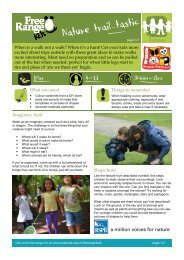Biodiversity Action Plan for the National Cycle Network ... - Sustrans
Biodiversity Action Plan for the National Cycle Network ... - Sustrans
Biodiversity Action Plan for the National Cycle Network ... - Sustrans
You also want an ePaper? Increase the reach of your titles
YUMPU automatically turns print PDFs into web optimized ePapers that Google loves.
10.6 Great crested newt Triturus cristatus<br />
10.6.1 Description<br />
The great crested newt is <strong>the</strong> UK’s largest newt, reaching an adult length of up to<br />
170mm. The adult newt is easily distinguished from <strong>the</strong> o<strong>the</strong>r two native newts (<strong>the</strong><br />
smooth and palmate) by size and colouring. The skin of <strong>the</strong> adult newt is very<br />
granular in appearance, with a black or dark brown colour and very fine white spots<br />
on its lower flanks. The male has a jagged crest along its back and tail, although this<br />
is less pronounced outside of <strong>the</strong> breeding season. Both sexes have a bright orange<br />
or yellow belly that is covered in irregular black spots. On land both sexes appear<br />
very black and <strong>the</strong> male’s crest is held against its body. Adults spend most of <strong>the</strong><br />
year on land, returning to water in early spring to breed. Eggs are laid on submerged<br />
vegetation and, like all newt eggs, are distinctive in that <strong>the</strong> female encloses each egg<br />
within a folded leaf of a water plant.<br />
10.6.2 Optimum survey time<br />
The optimum survey time <strong>for</strong> adult great crested newts is between late March and<br />
September as this is when newts are out of hibernation. Great crested newts are very<br />
difficult to survey on land, and breeding pond surveys are most successful. Although<br />
<strong>the</strong>y are known to travel up to 500 metres from <strong>the</strong>ir breeding pond, most do not<br />
travel more than 100 metres and, <strong>for</strong> distances greater than 200-250 metres, capture<br />
ef<strong>for</strong>t is hardly ever appropriate. The best time to carry out construction near to<br />
breeding ponds is between mid-April and mid-August. Outside of those times, and<br />
when <strong>the</strong> animals are not in hibernation, exclusion fencing along both sides of <strong>the</strong><br />
proposed path, will almost certainly be necessary. A search of records <strong>for</strong> great<br />
crested newts in <strong>the</strong> local area is certainly a good first step.<br />
10.6.3 Current status<br />
The great crested newt is still quite widespread in Britain. It is locally common in parts<br />
of England and Wales, but rare or absent in Devon and Cornwall. The British<br />
population is amongst <strong>the</strong> largest in Europe, where it is threatened in several<br />
countries.<br />
10.6.4 Status in relation to <strong>Sustrans</strong><br />
Great crested newts could be encountered throughout <strong>the</strong> <strong>Network</strong>, but particularly<br />
where <strong>the</strong> routes are close to a mosaic of habitats (woodland, grassland, ponds etc.).<br />
The <strong>Network</strong> could prove particularly important as commuting corridors <strong>for</strong> newts.<br />
10.6.5 Legislation<br />
The great crested newt is listed on Annexes II and IV of <strong>the</strong> EC Habitats Directive and<br />
Appendix II of <strong>the</strong> Bern Convention. It is protected under Schedule 2 of <strong>the</strong><br />
Conservation (Natural Habitats, etc.) Regulations, 1994, (Regulation 38) and Schedule<br />
5 of <strong>the</strong> WCA 1981. It is a Priority species in <strong>the</strong> UK BAP.<br />
10.6.6 Current factors affecting <strong>the</strong> species<br />
Loss of suitable breeding ponds caused by water table reduction, in-filling <strong>for</strong><br />
development, agricultural changes, waste disposal, neglect or fish stocking and<br />
<strong>the</strong> degradation, loss and fragmentation of terrestrial habitats.<br />
Pollution and toxic effects of agrochemicals.<br />
<strong>Sustrans</strong>’ <strong>Biodiversity</strong> <strong>Action</strong> <strong>Plan</strong> <strong>for</strong> <strong>the</strong> <strong>National</strong> <strong>Cycle</strong> <strong>Network</strong> (December 2007)<br />
31


